Water radiators: features of wall, floor and floor-standing
Looking at the floor heating water radiators and the classic wall, many are lost, which is better to choose for arranging your own house or apartment. It should be borne in mind that these two areas are also divided into many subspecies, which also have different technical characteristics.
To make it easier for you to navigate the abundant offerings of the current market of heating devices, we will try to provide you with the most complete information on them.

Direction number 1: wall radiators
This type of heater is more traditional and is probably familiar to everyone. Cast iron "harmonicas" installed on the walls warmed us in childhood. Today, not only cast iron models are used, but also from other more modern materials. But let's get all in order:
Cast iron
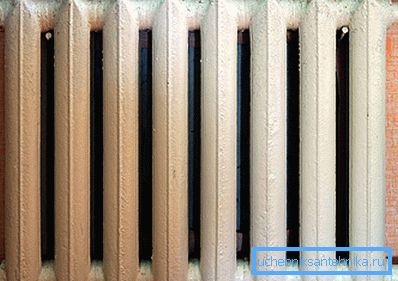
As we have already noted, these are representatives of the old generation of water radiators, the technical parameters of which look like this:
| Parameter | Value |
| Thermal transfer power of one section | 80-160 W |
| Withstand pressure | Up to 15 atm. |
| Maximum working temperature | +150 degrees Celsius |
Most of the heat such devices emit by radiation and only about twenty percent by convection.
Positive sides:
- Resistance to heat carriers of poor quality, which is of no small importance in urban centralized heating systems.
- Durability. The operational period is at least 35 years.
- The high threshold of working pressure, which allows to withstand without consequences the hydraulic shocks that occur when starting the boiler room after summer idle time.
- Low price.
Negative sides:
- Low level of heat transfer. And this is still the main function of batteries.
- A very large weight that delivers a lot of difficulties in the process of mounting their own hands and forcing the use of reinforced fasteners.
- The need for painting.
- Great inertia, causing inconvenience in case of frequent changes in weather conditions.
Steel

The steel radiator consists of two rectangular sheets welded together with channels for the movement of the coolant of the heating system. As a rule, such samples are factory powder painted and do not need additional finishing.
Characteristic parameters:
| Parameter | Value |
| Thermal transfer power of one section | 450-5700 W, such a big difference is explained by a direct dependence on the linear parameters of the battery, which in turn can vary significantly |
| Withstand pressure | 6-10 atm. |
Pros:
- Fast heating and high heat dissipation.
- Relatively low cost.
- Simple installation instructions.
Minuses:
- Low threshold operating pressure, which may cause a rupture during a water hammer.
- Susceptibility to corrosive processes.
Tip: be sure to install valves on steel radiators so that there can always be liquid inside them. In the opposite case, the appearance of air as a result of the coolant discharge will significantly accelerate corrosion.
Aluminum
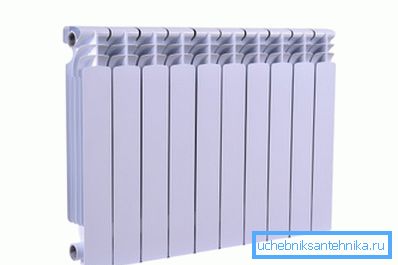
Immediately it is necessary to highlight two technologies for the production of aluminum radiators:
| Title | Description |
| Casting | All sections are cast separately, and then welded to the bottom and top elements. |
| Extrusion | Molten aluminum is forced through steel plates that have holes of a certain shape. Bottom and top elements are welded to the resulting structures. |
These types of radiators of water heating transmit 50% of the radiation and the same amount of convection.
Technical specifications:
| Parameter | Value |
| Thermal transfer power of one section | 160 watts |
| Withstand pressure | 16 atm |
Advantages:
- Attractive appearance that blends in well with the modern interior.
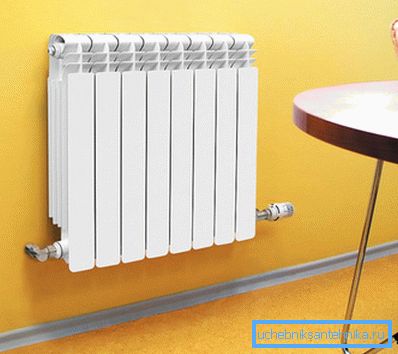
- The possibility of the implementation of individual sections.
- Light weight
- Compact size.
- High heat transfer coefficient.
Disadvantages:
- High sensitivity to coolant composition.
Tip: It is recommended to use aluminum batteries only in those houses where you can control the acidity of the liquid moving through them, because if this parameter exceeds the permissible limits, then the corrosion will quickly plug the internal channels of the structure.
- Intensive release of hydrogen sulfide within the system, which leads to the frequent formation of air traffic jams.
Tip: be sure to equip aluminum radiators with special valves for air release. So you can at any time eliminate the accumulation of gases.
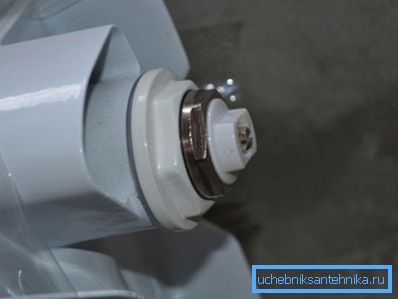
Bimetallic
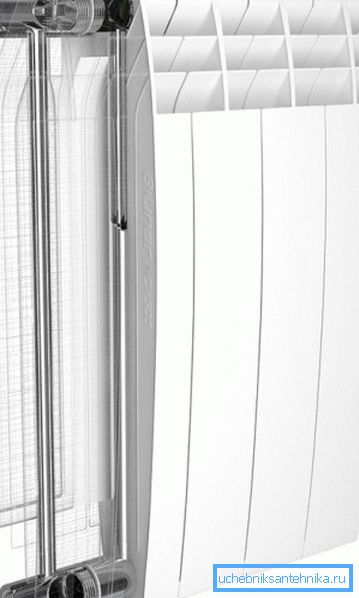
In fact, these products are aluminum structures with steel tubes embedded inside. This allows them to combine at the same time the advantages of batteries made of aluminum and steel, which guarantees high technical parameters:
| Parameter | Value |
| Thermal transfer power of one section | 200 watts |
| Withstand pressure | 35 atm |
Pros:
- Resistance to any type of coolant.
- High threshold withstand pressure.
- A light weight.
- Very high heat dissipation.
- Repair of water heating radiators of this type can also be carried out in sections.
By cons, in fact, should be attributed only to the high cost.
Direction number 2: floor and floor radiators
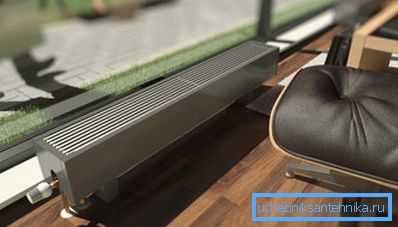
The device of this type consists of a copper-aluminum pipe along which the coolant moves, and metal plates welded to it perpendicular to it, designed to increase the heat exchange area. As a result of his work, the cold air descends, heats up and rises again. Often, to increase the performance factor, such convection radiators of water heating are equipped with fans, which are carried out by forced traction.

By type of installation are:
- Outdoor devices, characterized by mobility and ease of installation. You just need to put the heater in the right place.
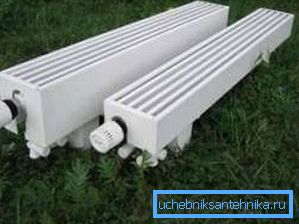
- Flooring appliances. Here, the main advantage is the saving of space and aesthetics, but installation is required to think over at the stage of installing the floor.

The water baseboard radiator allows you to create an effective thermal curtain in front of a panoramic window or a frequently opening door and boasts the following advantages:
- High speed warming room.
- The need for a small amount of coolant, which leads to significant savings.
- Efficiency even in the case of a drop in water temperature to +50 degrees Celsius.
- Low weight.
- The lack of a high degree of heating of the hull, which eliminates the possibility of a burn.
System "water warm floor"
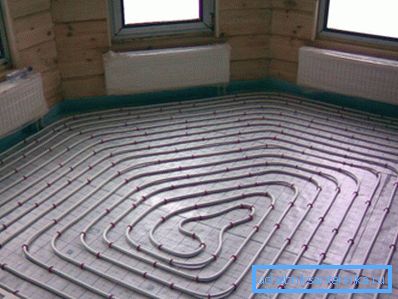
Why do radiators of water or steam heating in some cases replace the “water heated floor” system? This is a simple explanation, clearly demonstrated in the following diagram:

Thus, we see that radiators heat mainly the space around them and at the top of the room, but the “warm floor” creates the ideal microclimate exactly where the tenants constantly move.
But all the same, it is impossible to unequivocally answer the question whether radiators or a water-heated floor are better. As it is necessary to take into account both expenses, and planning possibilities, and many other factors.
Conclusion
Warm water floor or radiators, wall-mounted batteries or floor convectors? These questions should be answered individually for each situation, and the above information will help you decide on the final choice. Most importantly, remember that the ultimate goal is the creation of an ideal microclimate taking into account optimal financial costs.

The video in this article will introduce you to additional materials that are directly related to the presented topic. Take care to keep your home warm and comfortable.